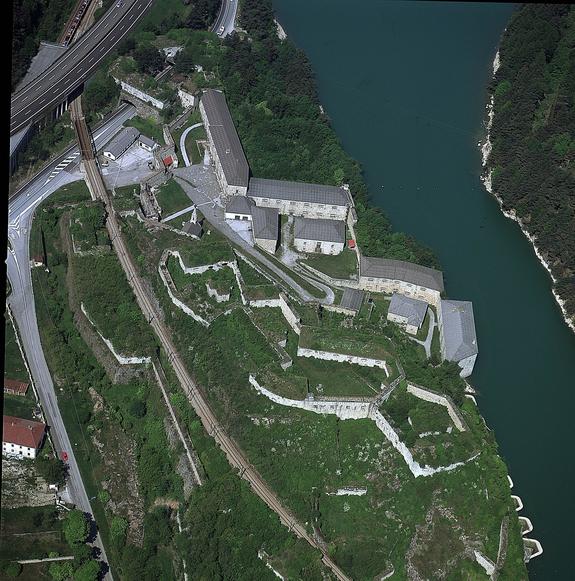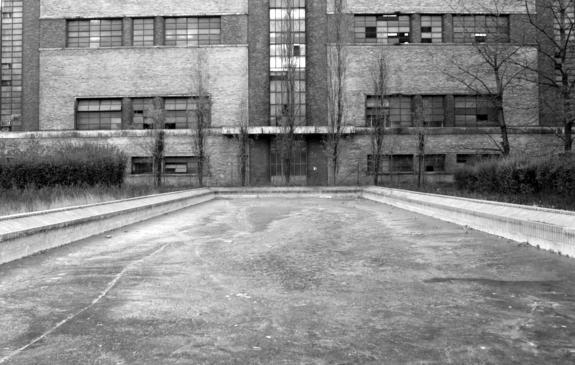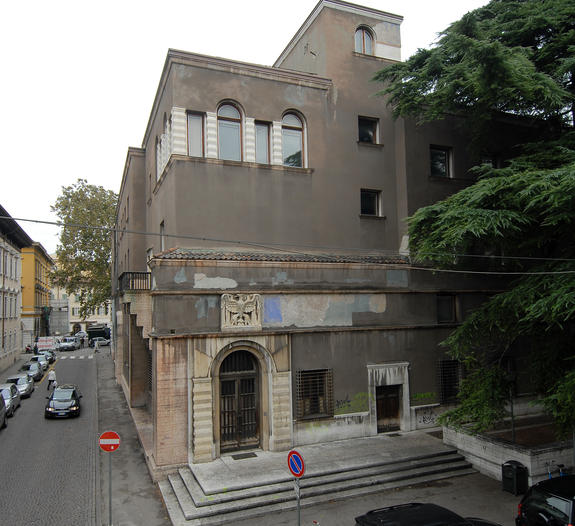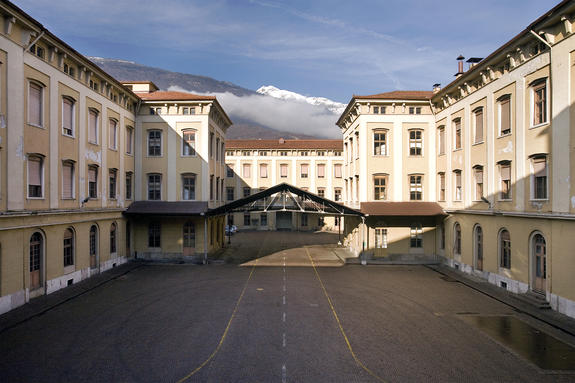

locations
FORTEZZA/FRANZENSFESTE
ADAM BUDAK, ANSELM FRANKE/HILA PELEG, RAQS MEDIA COLLECTIVE: "SCENARIOS"
FORTE ASBURGICO, EISACKTAL/VALLE ISARCO,
FRANZENSFESTE/FORTEZZA, ITALY

Situated on one of Europe’s most important travel routes, between Bolzano/Bozen and the Brenner pass, the fortress Fortezza/Franzensfeste will serve as one of Manifesta 7’s venues. It was built in the 1830s by the Habsburgian Empire in order to defend the north/south passage through the Dolomite mountain region from two sides. Shaped and ruled by changing military scenarios, which mostly remained imaginary, since the fortress has never witnessed battle, the site itself constitutes the basis for formulating the artistic context of the exhibition by Manifesta 7.
The project entitled Scenarios aims to transform the spectacular backdrop of Fortezza/Franzensfeste into a scripted space with voice recordings, text, light and landscape in order to alter our idea of how imaginary scenarios shape our understanding of past and future, circumstance and possibility. Scenarios will be an ‘immaterial’ exhibition, that attempts to shift the site of the exhibition to the imagination of the listening visitor. Writers from all over the world contribute texts to Scenarios, especially developed for this context. These texts reflect the processes of scenario production and imaginative possibility itself. As voice recordings, the texts are individually installed as sound works in the repetitive interior spaces of the fortress, in an architectural setting characterised by the absence of its historical users and the scenarios they were once part of.
Scenarios is a critical reflection of the role that scenarios occupy in our society and the individual or collective imaginary. Today, though often unconscious or involuntary, we are part of “scenarios” that have already been projected on and framed us, preconceived our presence, and conditioning the situations and experiences of everyday life. The project aims to make us reflect on how we come to complete the scenarios and stories by becoming part of them. As an exhibition project, Scenarios thus shows no (or little) images, but rather reflects on those already we carry with us, that are imposed on us, or which creative imagination brings about. It is meant to explicitly break with the regime of visibility, and the production of (material) evidence.
Adam Budak, Anselm Franke/Hila Peleg, Raqs Media Collective
SCENARIOS
Dramaturgy by Ant Hampton, Audio Design by Hannes Hoelzl, Furniture Design by Martino Gamper
CONTRIBUTORS
Shahid Amin, Hélène Binet, Brave New Alps, Adriana Cavarero, Mladen Dolar, Harun Farocki, Karø Goldt, Larry Gottheim, Renée Green, Timo Kahlen, Karl Kels, Thomas Meinecke, Glen Neath, Margareth Obexer, Philippe Rahm, Arundhati Roy, Saskia Sassen, Michael Snow, Saadi Yousef
BOLZANO/BOZEN
RAQS MEDIA COLLECTIVE: "THE REST OF NOW"
EX ALUMIX, VIA VOLTA 11, I-39100 BOLZANO/BOZEN, ITALY

“The extraction of value from any material, place, thing or person, involves a process of refinement. During this process, the object in question will undergo a change in state, separating into at least two substances: an extract and a residue. With respect to residue: it maybe said it is that which never finds its way into the manifest narrative of how something (an object, a person, a state, or a state of being) is produced, or comes into existence. It is the accumulation of all that is left behind, when value is extracted… There are no histories of residue, no atlases of abandonment, no memoirs of what a person was but could not be.”
(Raqs: With Respect to Residue, 2005)
What transpires in the course of a second, closer look at the narrative of progress and the velocity of our times?
Our effort is to subject these realities to critical reappraisal. The setting of part of Manifesta 7 in a disused aluminium factory in Bolzano – a space of abandonment and residue – raises many questions about the after-life of extraction. What gets left behind when everything is taken away? What can be retrieved, and what can be remembered? How can the residual become the engine of meaning?
We are interested in thinking about what happens when things are rendered as valuable in this world. It involves a slowing down, aconcentration of attention on some processes that might otherwise attempt to obscure those traces that are left behind. In one sense, it is an attempt to come to terms with the self-fulfilling amnesia of Capitalism, and to see what can be salvaged from the oblivion to which the residues of Modernism are normally consigned.
The task of creating a network of processes and art works inside an abandoned industrial site seems to us to be the perfect opportunity to invite artists – and some participants who do not practise as artists – to enlarge the horizons of this conversation.
While Europe is already known for art spaces and events that occupy abandoned industrial sites, there still remains the question of what the combination of remembered industrial energy and a more current melancholia of abandonment actually means today. In some ways this is symptomatic of Europe’s unwillingness to come to terms with aspects of its own difficult path into, and through, the 20th century.
Raqs Media Collective
THE REST OF NOW
ARTISTS
David Adjaye, Stefano Bernardi, Kristina Braein, Yane Calovski, Candida TV, contemporary culture index, Neil Cummings and Marysia Lewandowska, Harold de Bree, Latifa Echakhch, Marcos Chaves, etoy.CORPORATION, Anna Faroqhi, Ivana Franke, Matthew Fuller, Francesco Gennari, Ranu Ghosh, Rupali Gupte and Prasad Shetty, Anawana Haloba in collaboration with Francesca Grilli, Graham Harwood, Nikolaus Hirsch & Michel Müller, Hiwa K, Emre Hüner, Helen Jilavu, Sanjay Kak, Zilvinas Kempinas, Reinhard Kropf and Siv Helene Stangeland, Anders Krueger, Lawrence Liang, Charles Lim Yi Yong, m-city, Teresa Margolles, Walter Niedermayr, Jorge Otero-Pailos, Martin Pichlmair, Piratbyrån Party (featuring a performance by Jem Noble), Jaime Pitarch, Prof. Bad Trip, Kateřina Šedá, Dayanita Singh, TEUFELSgroup, Meg Stuart, Melati Suryodarmo, Jörgen Svensson, Hansa Thapliyal, Alexander Vaindorf, Judi Werthein, Graham Harwood, Richard Wright, Matsuko Yokokoji,
Darius Ziura
SPECIAL PROJECTS
Hot Desking: Four broadsheets, four cities, four events
A project in collaboration with Konstfack Curator Lab
Hot Desk Paris: J’aime beaucoup ce que vous faites
Hot Desk Istanbul: Muhtelif
Hot Desk Stockholm: Site Magazine
Hot Desk Rome: Nero Magazine
Tabula Rasa: 111 days on a long table
A project by Denis Isaia in conversation with Raqs Media Collective
“The Rest of Now” will be accompanied by a print publication edited by novelist Rana Dasgupta containing texts and images by Irina Aristarkhova, Ursula Biemann, Ingrid Book and Carina Hedén, Espen Sommer Eide, Lakhmi Chand Kohli, Anders Kreuger, Ove Kvavik, J Robert Lennon, Lawrence Liang, Daniel Magnusson, Christien Meindertsma, Naeem Mohaiemen, Jeffrey Schnapp, Ravi Sundaram, Jeet Thayil, Cédric Vincent, and others.
TRENTO
ANSELM FRANKE/HILA PELEG: "THE SOUL (or, Much Trouble in the Transportation of Souls)"
PALAZZO DELLE POSTE, VIA S.S. TRINITA’ 27, I-38100 TRENTO, ITALY

This project proposes to examine today’s Europe not as an expanding geopolitical entity but in regard to the engineering of its psyche or soul. Trento, the city of the historic Council of Trent and of this part of Manifesta 7, provides the immediate background for the project.
As an archeology of reversals between inside and outside, self and other, individual and collective, The Soul follows the historical turning-inwards of the expansionist boundaries of European modernity and suggests that the production, mobilization, and representation of the inner self is a final frontier, a last outside.
Here the soul is not understood or treated as fact but as a cultural object, an allegory for social relations shaped by ideas and techniques of power. Much like the “discovery” of a continent, these techniques have produced and invented an entity they declared to map objectively. And yet this entity, the psyche—if only as the difference between material and immaterial, body and mind, object and subject—has never been entirely contained by positivist science. Its properties (emotion, memory, imagination, fantasy, self-consciousness) remain haunted by its own otherness, a minefield of displacements.
It was in Trento that the catholic doctrine of the relation between the soul and representation was articulated some five hundred years ago. And it was here that the rules for Christian confession were expanded to include purely projective, imaginary deeds and thoughts, thus marking an important step in the construction of the modern European self: the policing and self-policing of the interior.
This history unfolds in the exhibition as a set of miniature museums, which sketch possible, alternative, or incomplete histories of the psyche and the soul. These are study displays that investigate the embodiment of power in its affective and cognitive dimensions, experiment with the tradition of the museum, and bring into focus the paradoxes of a “European normality”, the relation between soul and image, nonphonetic pedagogy, structures of feelings, the logic of desires, psychological personality tests, and the history of antipsychiatry.
Next to this series of speculative museums, The Soul brings together recent and specially commissioned works by over thirty artists working in Europe and elsewhere. Some contributions engage with the site of the exhibition and its regional, political, and historical context. Others take the form of “deep” historical research, confronting the mythical contents of European history with the technologies of power and the power of cultural technologies. The entire exhibition is a search for languages capable of identifying and articulating new forms of exclusion and possibilities for reversing forms of social control.
Anselm Franke/Hila Peleg
THE SOUL
(or, Much Trouble in the Transportation of Souls)
CONTRIBUTORS
Nader Ahriman, Maria Thereza Alves / Jimmie Durham / Michael Taussig, Tamy Ben-Tor, Attila Bruni, Beth Campbell, Fabio Campolongo, Marcus Coates, Peter Coffin, Keren Cytter, Jos De Gruyter / Harald Thys, Massimiliano & Gianluca De Serio, Brigid Doherty, Omer Fast, Peter Friedl, Stefano Graziani, Tom Holert / Claudia Honecker, Karl Holmqvist, Hannah Hurtzig, Joachim Koester, Andree Korpys / Markus Löffler, Kuehn Malvezzi, Daria Martin, Angela Melitopoulos, Xisco Mensua, Valérie Mréjen, Rabih Mroué, Andreas Müller, Sina Najafi / Christopher Turner, Rosalind Nashashibi, Luigi Ontani, Ria Pacquée, Bernd Ribbeck, Pietro Roccasalva, Roee Rosen, Christoph Ruckhäberle, Natascha Sadr Haghighian, Florian Schneider, Eyal Sivan, Josef Strau, Javier Tellez, Althea Thauberger, Anne-Mie Van Kerckhoven, Barbara Visser, Klaus Weber,
Eyal Weizman
Texts in Pubblication:
Franco Berardi, Brigid Doherty, Tom Holert, Maurizio Lazzarato, Eva Meyer, Avi Pitchon, Renata Salecl, Michael Taussig, Anne-Mie Van Kerckhoven, Eyal Weizman, et al.
ROVERETO
ADAM BUDAK: "PRINCIPLE HOPE"
EX PETERLINI, VIA SAVIOLI 20 – MANIFATTURA TABACCHI, P.ZZA MANIFATTURA 1 -STAZIONE FERROVIARIA, PIAZZALE ORSI, I-38068 ROVERETO, ITALY

The exhibition (and beyond) project developed by Adam Budak’s Manifesta 7 curatorial unit (Nina Möntmann, Tobi Maier, Krist Gruijthuijsen, Office for Cognitive Urbanism – Christian Teckert and Andreas Spiegl) is focused on mapping and analysing the (cultural and political) ecology of space and its public-ness. As such it aims at elaborating provisional (exhibition) strategies and critical (discursive) services that would be leading towards ANOTHER (gentle manifesto for) public space.
The notion of “critical regionalism” (as introduced by architectural theorist, Kenneth Frampton) functions as a blackboard where the reconsideration of the vernacular takes place and a renewed vocabulary of trans-locality is articulated. Such idea which identifies a public space as an area of multiple values exchange focuses on investigating (public) discourse’s “proper” place, between a plurality of definitions and precarious temporariness of public matters. A variety of qualities and economies will be at stake: from the “proper” space (property) via “legal” space (ownership and legality) down to autonomous space (emancipation) towards the precise mapping of the “peculiarities of a particular place”.
Critical regionalism – “a local life aware of itself” – serves as a means to resolve tensions between globalization and localism, modernity and tradition, and as such it marks a form of resistance – a decisive reaction to normative, universal standards, practices, forms as well as technological and economic conditions. It raises a variety of urgent questions concerned with historicism, national romanticism, authenticity and the nation-state and it further opens up a field to deconstruct the modes of (spatial/national/singular) belonging and identification by employing defamiliarization: interested in specific elements from the region, those that act as generators of contact and community, and are place-defining constructs, critical regionalism incorporates them “strangely” rather than familiarly thus disrupting the sentimental “embracing” between buildings and their inhabitants and triggering the conscience. According to Frampton, thinking in terms of regions – active agents of resistance – brings the tactile immediacy of spatial experience, the necessary response to climate and topography, a sense of reality to the cultural meaning of architectural form, and the possibility of engaging local labour and skill in architectural production. The northern Italian region of Trentino Alto Adige (as a host of Manifesta 7) and especially Rovereto (as the smallest town in the biography of Manifesta so far) and its post-industrial sites (Ex-Peterlini and Tobacco Factory as the exhibition’s venues) are case studies in the process of defining anew the conditions of the vernacular in the social and cultural environment of seemingly blurred divisions between the public and the private, precariously oscillating between the not-yet-constituted, autonomous (post)political and a beyond-state emancipated micro-structure of communal identity-in-process.
Furthermore, the exhibition considers space’s ethnology as a methodological reference in focusing on “minor” local, the concrete, small and seemingly insignificant and marginal within a ruined landscape of delayed processes of restructurisation and post-industrial transformation. Ernst Bloch’s philosophy of the vernacular and especially his elaboration of Kleinstadt complement the mapping of cross-regional matrix of identity politics. Here, the Kleinstadt appears as a Model, a Figure, a Primary Structure – a space for the ambiguities and dialogical forms of communication that are associated with the modern culture; and the vernacular is defined as a particular state of mind, a “difference of place”. In Bloch’s philosophy, the small town is an active area, far from nostalgic longing and a trauma of abandonment, a dynamic place where modernity encounters its own contradictions and elaborates its complex grammar of physical and mental belonging. Bloch advocates an open concept of reality where (not-yet)Being is concerned as Possibility and Hope is Being’s principle, a human driving force leading towards a better future and improvement. Hope is a reverie, but also docta spes, a (sustainable) desire or/and desire of sustainability. The project aims at navigating through the dilemmas of the principle that shapes and determines our life in a permanent passage between a (concrete) utopia and a promise of a real encounter. How to register the “not-yet” of Being’s (social and political) development, how to spot a trace of hope in the noise of an aggressive rhetoric of (already) corrupted future? Hope is a mental outline of an (optimistic) projection towards the not-yet-defined (or rather -conscious) temporal and spatial parameters, a movement towards the undisclosed and unknown: “an imagined space of emergence”, an agent of the vernacular. As such, hope is a hybrid concept, a mediator between the praxis and theory and the operator of the (anticipatory) identity.
One of the important chapters of the entire project will concentrate on the confluences and contradictions of the “post-political” within the public space and its communal and would-be democratic scaffolding. Facing the growing impossibility of a social autonomy on the one hand and an emancipatory drive on the other, the public space undergoes a troublesome process of identity disorder: as a “powerless structure” of denied access and a (still seductive and fertile) field of activism and radical imagination. Over-semanticised, it appears as an overrated gesture and a site of collapse yet still it appeals as an area of potentiality and (unconditioned) commitment: such is the public space as a field of power, in a permanent friction between the right, potency and its latent frailty. The project offers a journey towards methodologies of resistance in negotiating public space’s legitimacy by jamming imaginative topographies of Jorge Luis Borges’ “The Circular Ruins” (an amalgam of appearance, dreaming and utopian desires) with Jacques Ranciere’s “active parliament” (a search for a telos of community on the crossway of the end of the politics, or/and the realist utopia).
Adam Budak
PRINCIPLE HOPE
ARTISTS
Alterazioni Video, Michelangelo Antonioni, Knut Åsdam, Bernadette Corporation, Margrét H. Blöndal, Michal Budny, BURGHARD, Nina Canell, Libia Castro & Ólafur Ólafsson, Claire Fontaine, Oskar Dawicki, Evelina Deicmane, Rä di Martino, Miklós Erhardt and Little Warsaw, Igor Eskinja, Tim Etchells, fabrics interseason, Famed, Didier Fiuza Faustino, João Maria Gusmão + Pedro Paiva, Heide Hinrichs, Heidrun Holzfeind, Runa Islam, Ricardo Jacinto, Ragnar Kjartansson, Barbora Klímová, Daniel Knorr, Adam Leech, Deborah Ligorio, Miks Mitrevics, Christian Philipp Müller, Ewa Partum, Gianni Pettena, Riccardo Previdi, Philippe Rahm, Pamela Rosenkranz, Janek Simon, Luca Trevisani, Tatiana Trouvé, Uqbar Foundation, Guido van der Werve, Nico Vascellari, Danh Vo, Johannes Vogl, Stephen Willats, ZimmerFrei
featuring:
AUDITORY EPODE curated by Tobi Maier
Florian Hecker
Anna Ostoya
the next ENTERprise
Chris Watson
Zafos Xagoraris
RADIO EPODE @ Rai FM
manifeSTATION curated by the Office for Cognitive Urbanism (Andreas Spiegl, Christian Teckert)
Azra Aksamija
Andreas Duscha
Sonia Leimer
Christian Mayer
Kamen Stoyanov
Adrien Tirtiaux
Anna Witt
MATTER OF FACT curated by Krist Gruijthuijsen
Jeremiah Day
Renzo Martens
Olaf Nicolai
Adam Pendleton
Falke Pisano/ Will Holder
Ricardo Valentim
SOCIAL ART PRAXIS curated by Cornelia Lauf (IUAV, Venice)
Airswap
Aspramente
Publink
PUBLICATION
PRINCIPLE HOPE. DAYDREAMING THE REGION,
co-edited by Adam Budak and Nina Möntmann, with essays by T.J. Demos, Simon Critchley, Bernd Hüppauf, Suzana Milevska, Jochen Becker, Erden Kosova, Alan Colquhoun and Gianni Pettena, conversations between Marco de Michelis and Franco Rella, Mirko Zardini and Gianni Pettena, Nina Möntmann and Ayreen Anastas & Rene Gabri, Judith Butler and Gayatri Chakravorty Spivak, art contributions by Uqbar Foundation and Christian Philipp Müller, as well as introductions by Nina Möntmann and Adam Budak.
Editorial manager: Dan Kidner